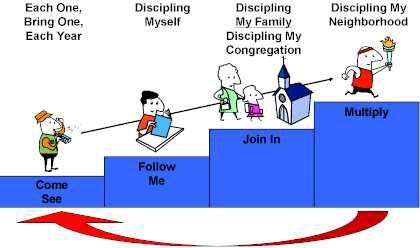Greetings! In my roles with Amy Foundation Publishers and the Coffee Shop Church, my wife Gina and I have been busy this Fall providing workshops at church ministry conferences all over the Midwest. We explain the spiritual maturity model Jesus applied in training his disciples and offer a free Spiritual Maturity Index to score your group's maturity. Once scored, you can look for weaknesses that the group shares and collectively work to strengthen them.
How do you measure a group's disciple-making effectiveness? We open God's Word and build community, but are we really providing the best opportunity for our members to develop spiritual maturity through life change? (Bonus: Follow along with our PowerPoint presentation.)
Two-part Model. In workshops, we seek to equip leaders (and teachers) with two tools to achieve the necessary balance between "knowledge gained" and "lives changed."
As the Christian church, we need to demonstrate our faith in action. According to recent polls, 84% of Americans claim at least a notional "Christian" faith and 70% say their personal faith is growing; however, 66% believe religion is losing its influence on society.[i] While we can legitimately question the respondents' definition of "Christian" and "faith," there is a clear disconnect between claiming our faith and living it.
We attribute the loss of faith in action to the emphasis on developing faith "knowledge" over developing habits and practices that exercise our faith. (The Apostle Paul predicted this in II Timothy 3:7 "…always learning but never able to acknowledge the truth.")
Small group leaders can counter this trend by insuring the activities, studies, and discussions follow the "Know-Be-Do" rule.[ii]
Knowledge development—"know" God's truth and what is required of us.
Character development—"be" like Christ in thought, word, and deed.
Action requirement—"do" what Christ is calling us to do.
How can a small group leader apply the rule? By balancing study with application and assigning activities outside of group. Here is a practical example:
Discussion on God's truth—John 1:6: "The light shines in the darkness, but the darkness has not understood it." (NIV)
Know—small group discussion: "What is the Apostle John trying to say in this verse? What are we supposed to get from this verse?"
Be—reflection: "In group discussion or sometime during the week, each group member should email their thoughts to the group on what "light" and "darkness" means to him/her."
Do—daily challenge: "Pray each day that God uses you this week to share Jesus' light with someone living in darkness. God is faithful, so act when he presents you the opportunity. Plan to report back to the group next week."
We need to understand and follow Jesus' Model. "Know-Be-Do" covers the "why" and "what" of developing spiritual maturity. Now it is time to deal with the "how" by understanding and applying the model Jesus followed in making his twelve disciples.
The simplistic model we use to explain Jesus' disciple-making process should look familiar. You can find similar models in numerous books, such as Training the Twelve, The Master Plan of Evangelism, and The Purpose-Driven Church/The Purpose-Driven Life. That is because the pattern—or model—is God-given, based on the practices and teaching of Jesus as he made the first disciples. The Amy Foundation's disciple-making plan is no exception; it is called, "Becoming a Christ-Centered, Disciple-Making Church." Here is a table that compares the approaches:
Simple Model[iii]
|
Amy Foundation |
Warren[iv] |
|
Phase 1 |
Come & See (John 1) |
Each One, Bring One … |
Fellowship |
Phase 2 |
Follow Me (Matt. 4) |
Discipling Myself |
Discipleship |
Phase 3 |
Join In (Matt. 10) |
Discipling My Family Discipling My Congregation |
Ministry |
Phase 4 |
Multiply (Matt. 28) |
Discipling My Neighborhood |
Mission |
This model shows the natural progression of people responding to Jesus' initial call to "come and see," demonstrated by Philip in John 1. The "follow me" challenge given to Peter and John after they had accepted Jesus as the Messiah (Matt. 4). They were willing to leave the lives they were leading for new lives in Christ. Jesus then spent three years training his disciples. Part of the training involved the disciples "joining in" ministry with Christ. One example is Jesus sending out the twelve disciples in Matt. 10. When Jesus completed the training, he challenged his followers to "multiply" in Matt 28:18-20:
Then Jesus came to them and said, "All authority in heaven and on earth has been given to me. Therefore go and make disciples of all nations, baptizing them in the name of the Father and of the Son and of the Holy Spirit, and teaching them to obey everything I have commanded you. And surely I am with you always, to the very end of the age." (NIV)
Because of Christ's example, his disciples knew what to do. See Acts 2 for results.
Phased Maturity. You, as a small group leader, can lead in life change by applying "know-be-do;" however, intentionally developing spiritual maturity also requires following a prescribed path, such as the phases described above. Now, we briefly explain the four phases (in the context of the Amy Foundation plan) and introduce a Spiritual Maturity Index, which measures maturity in each phase, according to "Know-Be-Do" rule.
Discipling Myself (Follow Me). We start with Phase 2 because this is where most believers are: inwardly focused on their spiritual maturity. It also is the easiest stage for people to grasp— you have to be a disciple in order to make disciples. Here is an example of how we apply "know-be-do" in this stage:
Know—group members understand what Jesus expects of them (i.e., spiritual disciplines, commands, etc.) and know how to apply them
Be—they exhibit the character and passive qualities of our faith (i.e., fruits of the Spirit, prayer, expressing gratitude and repentance, etc.)
Do—they practice the spiritual disciplines and loving God through acts of service
Discipling My Family (Join In). God ordained the institutions of marriage and family, and He expects us to use these structures to disciple our loved ones. It naturally becomes our first "mission field." Volumes have been written on how to have a good marriage, how to raise children properly, etc. We challenge spouses to center their relationships on God, parents to train their children, by example, in the spiritual disciplines, and all believers to champion marriage and family.
Discipling My Congregation (Join In). God established the church, and by extension, the small group. The small group gives structure and confidence to those people seeking to grow their faith. It also serves the leader as an opportunity for advancing personal maturity in Christ by helping others grow. Groups can become misdirected and dysfunctional, so we ask small groups to assess their discipling focus and personal ministry effectiveness by conducting a S.W.O.T. analysis (Strengths, Weaknesses, Opportunities, and Threats)
Discipling My Neighborhood (Multiply). Jesus spent a great deal of time trying to convince his followers to get to know their neighbors and to love them actively. He wants all of us engaged in making disciples by bringing those outside the church into a discipling fellowship. We ask tough questions. Are you open? Does your group practice "open seat"? Are members trained, praying, and serving? Through these questions, we challenge people and groups to grow.
Each One, Bring One, Each Year (Come See). We place the first phase last in sequence because it is a natural by-product of Discipling My Neighborhood/Multiply. How do people come to Jesus unless they hear about them from a credible source— someone living out his truth in everyday life? Those credible people are your group members. How do you measure this stage? New people start showing up for church and small group meetings.
Imagine a small group that is practicing "Each One, Bring One, Each Year." The group would double in size annually, birthing more groups. A group of 5 could spawn a small group ministry of 32 small groups and 160 people in 5 years. That's the power of Christ's growth model for the church— just consider how the first century church grew. (Admittedly, this type of numerical growth is a stretch, given small group and community building dynamics. Realistically, a group committed to making more and better disciples could reasonably reproduce 4 to 8 groups with 40 people regularly attending in 5 years.)

Measuring Maturity. Is your group ready to make disciples? It is often a question of maturity and how do you measure member's spiritual maturity. To assist you, we have reformatted the core disciple-making steps of our free plan, "Becoming a Christ-Centered, Disciple-Making Church," into a four-step evaluation or Spiritual Maturity Index. Here are the indices in PDF format:
Discipling Myself (Follow Me)
Discipling My Family (Join In)
Discipling My Congregation (Join In)
Discipling My Neighborhood (Multiply)
Download the files and score yourself. The statements and scoring are subjective, but it will provide a good indication where you need work (from our perspective). Consider ordering our free brochures, "Becoming a Christ-Centered, Disciple-Making Church," and distributing them to your group and then asking them to score themselves using the Spiritual Maturity Index. Perhaps the group will find the similar strengths and weaknesses that they share and will choose to study and work on a particular area. The Amy Foundation publishes disciple making specific materials that can help. If you are interested, please visit www.DisciplingDirect.com for more information.
[i] George Barna, "Is America's Faith Really Shifting?," 2/24/03, www.barna.org
[ii] The "Know-Be-Do Rule" belongs to Mark Steiner, president of Through the Bible Publishers, publishers of DiscipleLand® children's curriculum
[iii] Rob Freshour of the Baptist State Convention of Michigan (Southern Baptists) introduced us to the traditional model of disciple making
[iv] Rick Warren, "Purpose Driven Church," Zondervan; 1995








